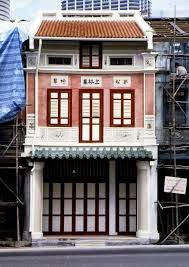The plans for conservation are elaborate. Firstly, different conservation districts are drawn up - historic districts (i.e Boat Quay, Chinatown, Kampong Glam and Little India), residential districts (i.e Emerald Hill, Cairnhill and Blair Plan), Secondary Settlements (i.e. Jalan Besar, River Valley, Geylang and Joo Chiat), as well as The Good Class Bunglow Areas and the Mounbatten Road Area. Guidelines on restoration work follow the 3R principle: Maximum Retention, Sensitive Restoration and Careful Repair. In short, a great deal of emphasis is on maintaining or adhering to a "certain look" or restoring the facade of tradition and culture in our otherwise extremely modern nation.
The photos below are evident of such attempts at conserving the structure and design of old shophouse buildings.
pre-restoration
after restoration
_____________________
pre-restoration
after restoration
_____________________
today vs. in the past
_____________________
The need of up upkeeping appearances is mirrored not just in our city's architecture but also in the daily lives of Singaporeans. Such a way of life is evident in texts such as Kuo Pao Kun's The Coffin Is Too Big For The Hole and Stella Kon's Emily Of Emerald Hill.
In Kuo's play, the big, grand looking coffin was meant to signify his grandfather's wealth and position in society. Even at death, the family had to ensure that onlookers were aware that the deceased was a prominent person from a well-to-do family, hence the elaborateness and grandeur of the burial and coffin. Furthermore, throughout the funeral, the protagonist was very mindful of the onlookers, repeatedly emphasising that their family was "watched" by "two hundred people". Hence much of how he behaved and reacted to the whole fiasco of the coffin being too large for the hole was an attempt to "save face" for the family. This was to be done by ensuring that the funeral procedure is followed through according to tradition, and not become a joke - although this has been done to comic effect: "it must have been the funniest thing that ever happened in the entire history of mankind"(Poon et al, 2009: 291).
In Emily of Emerald Hill, we see Emily putting up a strong front and trying to present the family as if things were going smoothly although they were not. In spite of the turbulent and unfortunate events within her family, such as her first son, Richard's suicide, the fact that she is always alone in her huge Emerald Hill mansion (all her children have moved out) and that her husband no longer loves her and is having an affair, she continues to host an elaborate dinner as if all is well. We can see she succeeds as the Singapore Free Press even reports the social event as a "splendidly-attended dinner". Of course, one could argue that her purpose of doing so would be to "force" her husband to end his extramarital affair. In addition, Emily's throws a party to reinforce their marriage in order to try to end her husband's affair, while saving the reputation of her unfaithful husband. This is another instance where appearance is key to maintaining people's perceptions of something.
Clearly, Singaporeans are highly mindful of how they are perceived in each other's eyes and the image in which they or their families portray. This can be metaphorically transposed to the maintenance of the appearance of buildings or heritage sites achieved through conservation efforts, which perhaps struggle to keep the impression of culture and tradition alive.
All in all, the conservation efforts of the URA are commendable, but ultimately, authorities have to realise that mere preservation of facade without content is not true conservation as our culture and heritage still face erosion.
References
URA conservation website
http://www.ura.gov.sg/uol/conservation.aspx#
Poon, A.;
Holden, P.; Lim, S. (2009) Writing Singapore: An Historical Anthology of
Singapore Literature. Singapore: NUS Press.






No comments:
Post a Comment